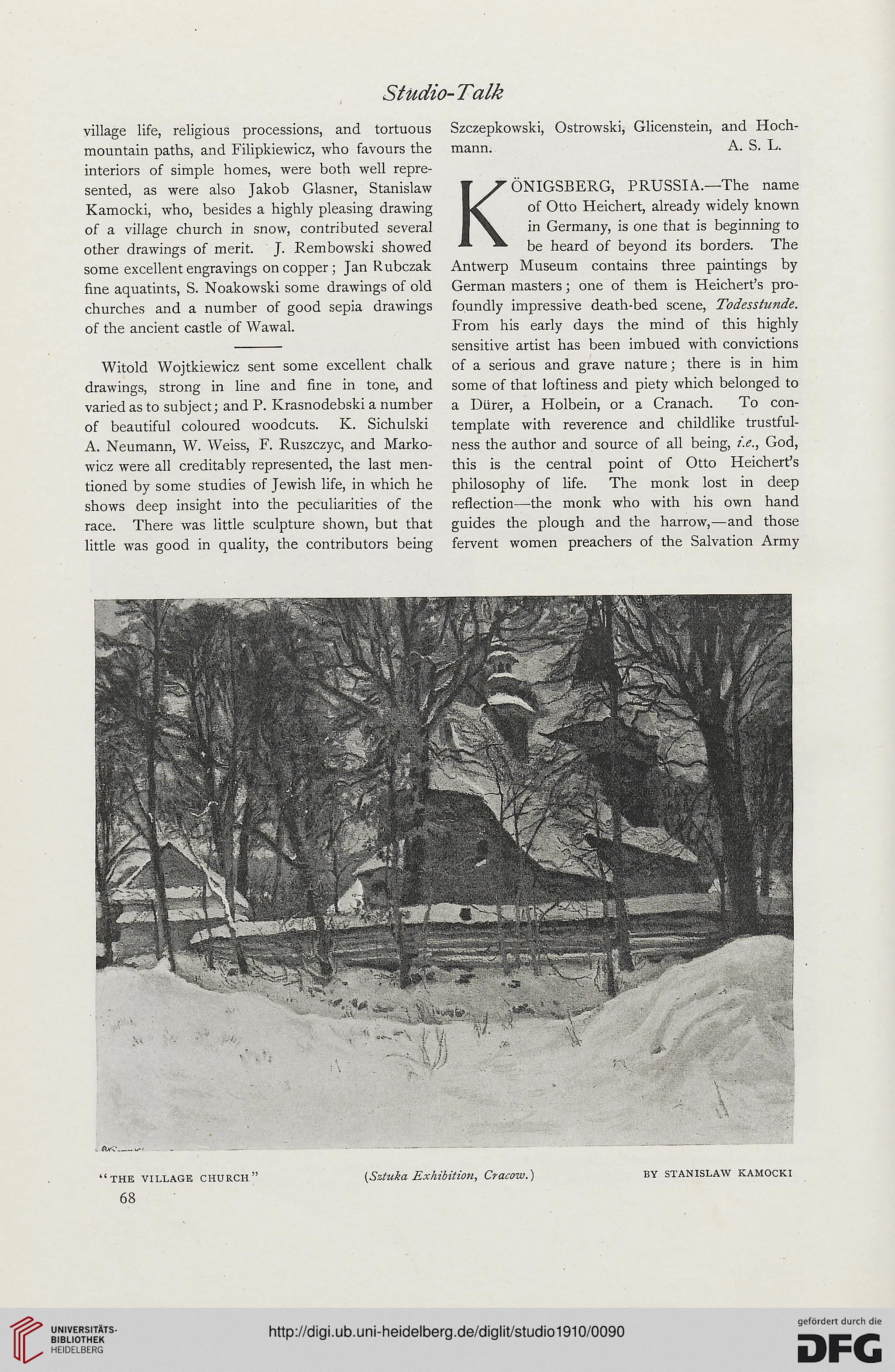Studio-Talk
village life, religious processions, and tortuous Szczepkowski, Ostrowski, Glicenstein, and Hoch-
mountain paths, and Filipkiewicz, who favours the mann. A. S. L.
interiors of simple homes, were both well repre-
sented, as were also Jakob Glasner, Stanislaw W f ONIGSBERG, PRUSSIA.—The name
Kamocki, who, besides a highly pleasing drawing 1^ of Otto Heichert, already widely known
of a village church in snow, contributed several I in Germany, is one that is beginning to
other drawings of merit. J. Rembowski showed ™- be heard of beyond its borders. The
some excellent engravings on copper; Jan Rubczak Antwerp Museum contains three paintings by
fine aquatints, S. Noakowski some drawings of old German masters; one of them is Heichert's pro-
churches and a number of good sepia drawings foundly impressive death-bed scene, Todesstunde.
of the ancient castle of Wawal. From his early days the mind of this highly
- sensitive artist has been imbued with convictions
Witold Wojtkiewicz sent some excellent chalk of a serious and grave nature; there is in him
drawings, strong in line and fine in tone, and some of that loftiness and piety which belonged to
varied as to subject; and P. Krasnodebski a number a Diirer, a Holbein, or a Cranach. To con-
of beautiful coloured woodcuts. K. Sichulski template with reverence and childlike trustful-
A. Neumann, W. Weiss, F. Ruszczyc, and Marko- ness the author and source of all being, i.e., God,
wicz were all creditably represented, the last men- this is the central point of Otto Heichert's
tioned by some studies of Jewish life, in which he philosophy of life. The monk lost in deep
shows deep insight into the peculiarities of the reflection—the monk who with his own hand
race. There was little sculpture shown, but that guides the plough and the harrow,—and those
little was good in quality, the contributors being fervent women preachers of the Salvation Army
"THE VILLAGE CHURCH"
(Sztuka Exhibition, Cracow.)
BY STANISLAW KAMOCKI
village life, religious processions, and tortuous Szczepkowski, Ostrowski, Glicenstein, and Hoch-
mountain paths, and Filipkiewicz, who favours the mann. A. S. L.
interiors of simple homes, were both well repre-
sented, as were also Jakob Glasner, Stanislaw W f ONIGSBERG, PRUSSIA.—The name
Kamocki, who, besides a highly pleasing drawing 1^ of Otto Heichert, already widely known
of a village church in snow, contributed several I in Germany, is one that is beginning to
other drawings of merit. J. Rembowski showed ™- be heard of beyond its borders. The
some excellent engravings on copper; Jan Rubczak Antwerp Museum contains three paintings by
fine aquatints, S. Noakowski some drawings of old German masters; one of them is Heichert's pro-
churches and a number of good sepia drawings foundly impressive death-bed scene, Todesstunde.
of the ancient castle of Wawal. From his early days the mind of this highly
- sensitive artist has been imbued with convictions
Witold Wojtkiewicz sent some excellent chalk of a serious and grave nature; there is in him
drawings, strong in line and fine in tone, and some of that loftiness and piety which belonged to
varied as to subject; and P. Krasnodebski a number a Diirer, a Holbein, or a Cranach. To con-
of beautiful coloured woodcuts. K. Sichulski template with reverence and childlike trustful-
A. Neumann, W. Weiss, F. Ruszczyc, and Marko- ness the author and source of all being, i.e., God,
wicz were all creditably represented, the last men- this is the central point of Otto Heichert's
tioned by some studies of Jewish life, in which he philosophy of life. The monk lost in deep
shows deep insight into the peculiarities of the reflection—the monk who with his own hand
race. There was little sculpture shown, but that guides the plough and the harrow,—and those
little was good in quality, the contributors being fervent women preachers of the Salvation Army
"THE VILLAGE CHURCH"
(Sztuka Exhibition, Cracow.)
BY STANISLAW KAMOCKI




